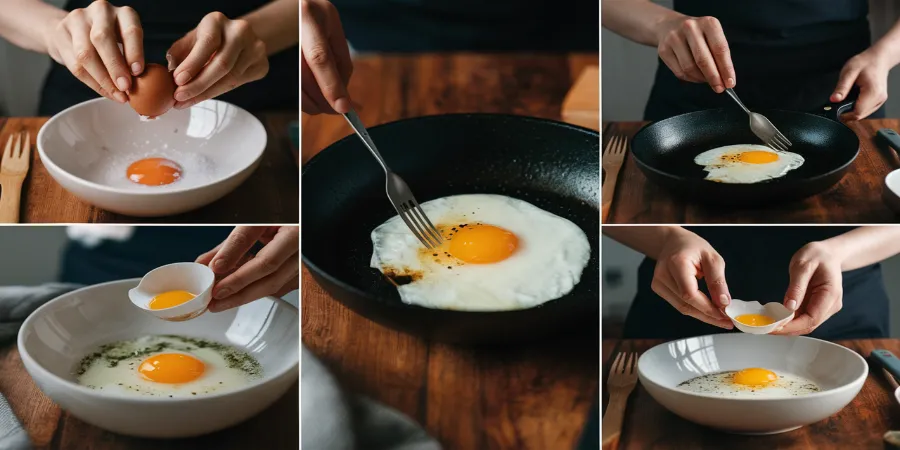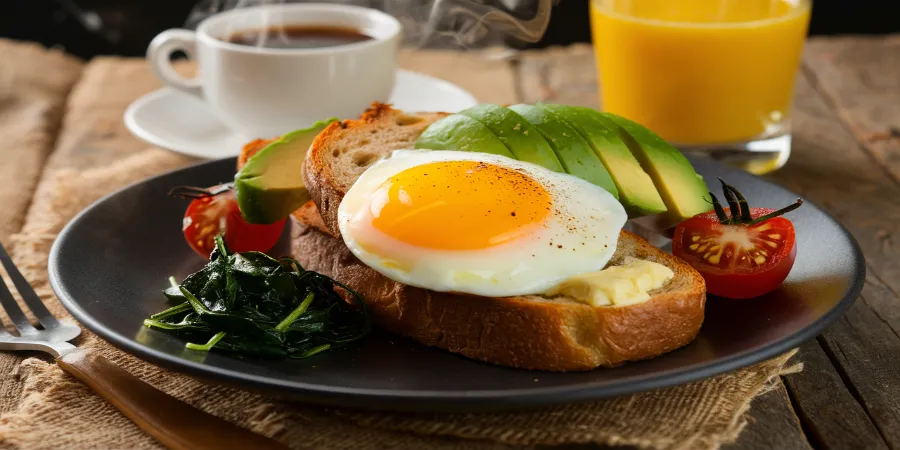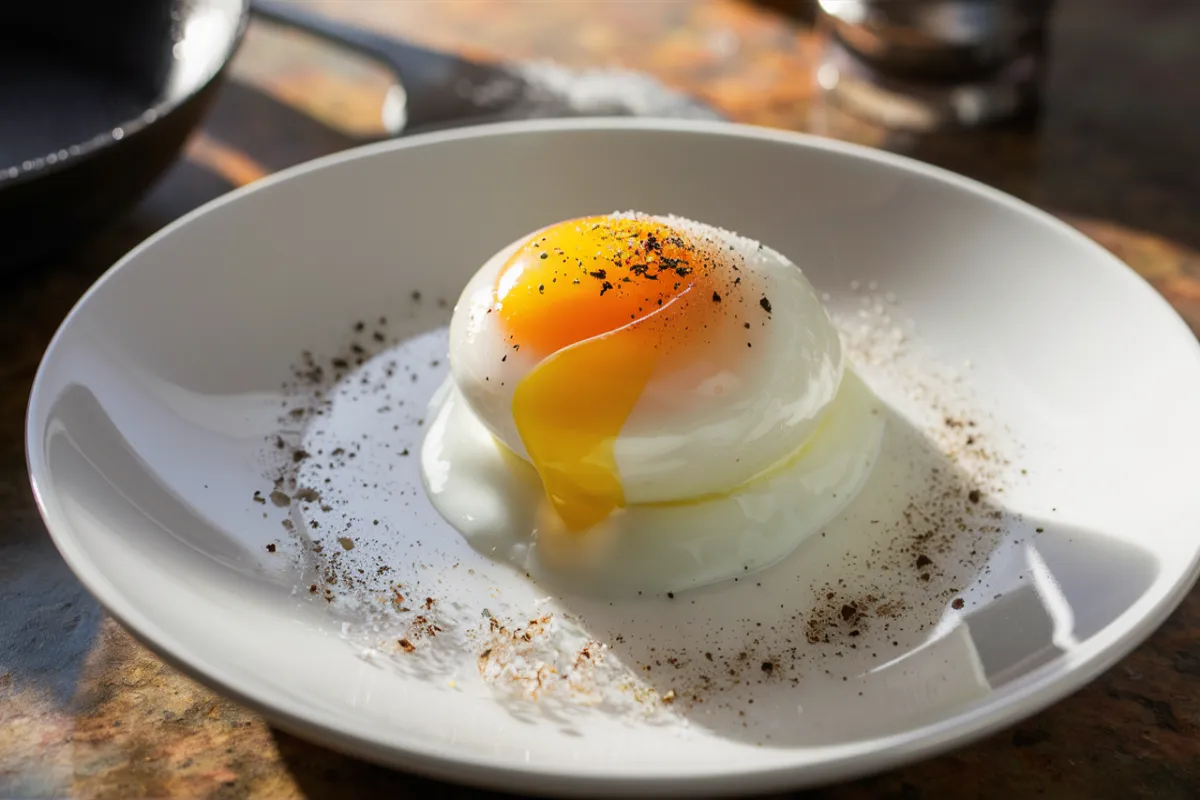Eggs are a staple in kitchens worldwide, celebrated for their versatility and simplicity. From scrambled to poached, each method of cooking eggs brings out unique textures and flavors. One method that stands out for its perfect balance between fully cooked whites and slightly runny yolks is “eggs over medium.” Mastering this technique can elevate your breakfast game, providing a delicious base for various meals or a simple, satisfying dish on its own.
In this comprehensive guide, we will walk you through everything you need to know about making eggs over medium. Whether you’re a seasoned cook or a beginner in the kitchen, this article will ensure you have all the tips and tricks to achieve the perfect result every time.
What Are Eggs Over Medium?
You fry eggs on both sides to make eggs over medium. The whites are cooked until firm, while the yolk stays slightly runny, providing a creamy texture that contrasts beautifully with the crisp edges of the whites. This cooking method sits between “over easy” (with a very runny yolk) and “over hard” (with a fully cooked, firm yolk).
Understanding the different styles of cooking eggs can help you choose the perfect preparation method for your tastes:
- Sunny-Side Up: The egg is cooked on one side only, with the yolk remaining runny and the whites only partially cooked.
- Over Easy: The egg is flipped, with a runny yolk and just set whites.
- Over Medium: The egg is flipped, and the yolk is cooked to a creamy consistency, while the whites are fully set.
- Over Hard: The egg is flipped, and the yolk is fully cooked through, resulting in a firm yolk.
Eggs over medium are often preferred for their balance—firm whites and a slightly runny yolk make them ideal for breakfast plates, sandwiches, or as a topping for various dishes.
Ingredients and Tools Needed
To make perfect eggs over medium, you’ll need a few basic ingredients and tools. While the list is simple, the quality of your tools and ingredients can significantly impact the final result.
Ingredients
- Eggs: Fresh, high-quality eggs are crucial. The fresher the eggs, the better the final result.
- Butter or Oil: Use a small amount of butter or oil to prevent sticking and add flavor. Butter will give a richer taste, while oil offers a neutral base.
- Salt and Pepper: Season to taste. These are the basic seasonings, but you can get creative with herbs and spices.
Tools
- Non-Stick Pan: A non-stick skillet is ideal for making eggs over medium. It prevents sticking and allows for an even cook.
- Spatula: A thin, flexible spatula is best for flipping the eggs without breaking the yolk.
- Stovetop: You’ll need a stovetop with adjustable heat settings to control the cooking process.
Optional Additions
- Herbs: Fresh or dried herbs like parsley, chives, or dill can enhance the flavor of your eggs.
- Cheese: A sprinkle of cheese can add richness.
- Hot Sauce or Salsa: For a bit of heat, try adding hot sauce or salsa to your eggs.
Step-by-Step Guide to Making Eggs Over Medium

Making eggs over medium requires a bit of technique, but with practice, you’ll be able to achieve the perfect balance between cooked whites and a creamy yolk. Follow these steps to master the process.
Step 1: Preparing the Pan
The first step in making eggs over medium is to prepare your pan. The type of pan you use and how you heat it will significantly affect the outcome of your eggs.
- Choose the Right Pan: A non-stick pan is recommended because it helps prevent the eggs from sticking and makes flipping easier. A pan that’s about 8 to 10 inches in diameter is ideal for cooking one or two eggs at a time.
- Preheat the Pan: Place the pan on the stovetop and turn the heat to medium. Allow the pan to heat for about 1-2 minutes. Preheating the pan ensures that the eggs will start cooking as soon as they hit the surface, which helps to create a nice, even crust on the whites.
- Add Fat to the Pan: Once the pan is hot, add about a teaspoon of butter or oil. Swirl it around the pan to coat the entire surface. If using butter, let it melt completely and start to foam, but do not let it brown, as this can give the eggs a burnt taste.
Step 2: Cracking and Adding the Eggs
Now that your pan is ready, it’s time to add the eggs. How you crack and add the eggs to the pan can impact the final look and texture of the dish.
- Crack the Eggs Carefully: Crack the eggs on a flat surface rather than the edge of the pan to avoid getting shell fragments in your eggs. Then, gently open the shell and let the egg slip into the pan. If you’re cooking multiple eggs, crack them into a small bowl first, then pour them into the pan one by one to ensure they cook evenly.
- Add the Eggs to the Pan: When adding the eggs to the pan, do so gently to avoid breaking the yolks. If you’re cooking more than one egg, make sure to space them out so they don’t touch each other. This helps to ensure even cooking and makes flipping easier.
- Season the Eggs: Season the eggs with a pinch of salt and pepper. If you’re adding herbs or spices, now is the time to do so. Keep in mind that salt can toughen the eggs if added too early, so a light sprinkle after the eggs are in the pan is best.
Step 3: Cooking the Whites
The key to eggs over medium is getting the whites cooked through without overcooking the yolk. So this requires careful monitoring and a bit of patience.
- Monitor the Heat: Keep the heat on medium to medium-low. Cooking the eggs too quickly on high heat can result in burned edges and undercooked whites. The goal is to cook the whites slowly until they are fully set but not browned.
- Cook Until the Whites Are Set: Watch the edges of the egg whites. They will start to firm up first. Once the whites are mostly set, and only a small amount of translucent white remains around the yolk, it’s time to flip the eggs. This usually takes about 2-3 minutes, depending on your stovetop and the pan.
- Avoid Disturbing the Eggs: While the eggs are cooking, resist the urge to move them around. Let them cook undisturbed to develop a nice crust on the bottom, which will help them flip more easily.
Step 4: Flipping the Eggs
Flipping the eggs is the trickiest part of making eggs over medium. The goal is to flip the eggs without breaking the yolk and cook the other side just enough to set the yolk to a creamy consistency.
- Use the Right Spatula: A thin, flexible spatula is best for flipping eggs. Slide the spatula gently under the egg, making sure to get it completely underneath without tearing the whites.
- Flip the Egg Gently: Once the spatula is under the egg, lift it slightly and tilt the pan away from you. Use a quick, gentle motion to flip the egg over. If you’re nervous about flipping, you can use the edge of the pan to help guide the egg over.
- Timing the Flip: The perfect time to flip is when the whites are set, and the edges are firm. If the yolk moves around too much or the whites are still jiggly, wait another few seconds before attempting to flip.
- Common Flipping Issues: If the yolk breaks, continue cooking and use the egg in a different dish, like a sandwich or scramble. If the egg sticks, gently work the spatula underneath until it releases.
Step 5: Cooking the Yolk to Over Medium
Now that you’ve flipped the eggs, it’s time to cook the yolk to the desired consistency. The goal for over medium eggs is a yolk that’s mostly set but still slightly runny in the center.
- Cook for an Additional Minute: After flipping, cook the eggs for another 1-2 minutes. The exact time will depend on your stovetop and the size of your eggs. You’re looking for the yolk to be firm around the edges but still have some give in the center.
- Test for Doneness: You can gently press the center of the yolk with your spatula to check for doneness. It should feel firm but not hard. If it feels too soft, cook for another 15-20 seconds.
- Avoid Overcooking: Be careful not to cook the yolk too long, or you’ll end up with over hard eggs. The key is to remove the eggs from the heat just as the yolk is setting but still retains some softness.
Step 6: Serving the Eggs
Once your eggs are cooked to perfection, it’s time to serve them. How you serve your eggs over medium can elevate the dish and enhance the eating experience.
- Plating the Eggs: Use your spatula to carefully lift the eggs out of the pan and onto a plate. Try to keep the yolk intact for the best presentation.
- Add Garnishes: Consider adding fresh herbs, a sprinkle of cheese, or a dash of hot sauce for extra flavor.
- Pairing Suggestions: Eggs over medium are delicious on their own, but they also pair well with a variety of sides. Serve them with toast, avocado, bacon, or as a topping for salads and sandwiches.
Common Mistakes and How to Avoid Them

Even experienced cooks can make mistakes when cooking eggs over medium. Here are some common pitfalls and how to avoid them.
Overcooking the Eggs
Overcooking is the most common mistake, resulting in tough whites and a fully cooked yolk. To avoid this:
- Monitor the Heat: Keep the heat at medium to medium-low.
- Cook Slowly: Take your time. Rushing the process will lead to overcooking.
- Check the Yolk: Press the yolk lightly to test for doneness and remove from heat just in time.
Breaking the Yolk
A broken yolk can ruin the perfect texture of eggs over medium. To prevent this:
- Crack Carefully: Crack the eggs on a flat surface to avoid shell fragments.
- Flip Gently: Use a spatula and a smooth, quick motion to flip.
- Practice: The more you practice, the better you’ll get at flipping without breaking the yolk.
Eggs Sticking to the Pan
Sticking eggs can be frustrating and ruin the presentation. To avoid sticking:
- Use a Non-Stick Pan: This type of pan is best for making eggs.
- Preheat Properly: Ensure the pan is hot and well-lubricated with butter or oil before adding the eggs.
- Don’t Move the Eggs: Let them cook undisturbed until ready to flip.
Health Benefits of Eggs Over Medium
Eggs are not only delicious but also packed with nutrients. Here’s why eggs over medium are a healthy choice:
Nutritional Value of Eggs
Eggs are a rich source of high-quality protein, containing all nine essential amino acids. They also contain a variety of vitamins and minerals, including:
- Vitamin A: Supports healthy vision and immune function.
- Vitamin D: Helps in calcium absorption and bone health.
- Vitamin B12: Important for red blood cell formation and brain health.
- Choline: Crucial for brain development and liver function.
Health Benefits of Eggs Over Medium
Cooking eggs over medium preserves most of their nutrients while offering a balance of textures. The slightly runny yolk retains more vitamins and minerals compared to fully cooked eggs.
- Lower Cholesterol: Contrary to old beliefs, eggs do not significantly raise cholesterol levels in most people.
- Healthy Fats: The yolk contains healthy fats, including omega-3 fatty acids, which are beneficial for heart health.
- Weight Management: Eggs are filling and can help with weight management by keeping you full longer.
Comparison with Other Cooking Methods
Compared to other methods like frying or scrambling with added fats, eggs over medium use minimal oil or butter, making them a healthier choice. The cooking process is quick, preserving more of the nutrients in the egg.
Variations of Eggs Over Medium
Eggs over medium are a versatile dish that can be customized in many ways. So Here are some delicious variations to try:
Spiced Eggs Over Medium
Add a kick to your eggs with spices like chili flakes, paprika, or cumin. Sprinkle the spices on the eggs while they cook, or mix them into the butter or oil before adding the eggs to the pan.
Different Cooking Fats
Experiment with different fats to change the flavor profile of your eggs:
- Olive Oil: Adds a fruity, slightly peppery flavor.
- Ghee: Clarified butter that gives a rich, nutty taste.
- Coconut Oil: Offers a subtle sweetness, ideal for pairing with tropical flavors.
International Variations
Explore global flavors by incorporating ingredients from different cuisines:
- Mexican Huevos Rancheros: Serve eggs over medium on a tortilla with salsa, beans, and avocado.
- French Oeufs à la Provençale: Top with herbes de Provence and a drizzle of olive oil.
- Middle Eastern Shakshuka: Cook eggs in a spicy tomato and pepper sauce.
Serving Suggestions and Pairings

Eggs over medium are incredibly versatile, pairing well with a variety of dishes. Here are some ideas:
Classic Pairings
- Toast: A slice of buttered toast is a classic accompaniment.
- Bacon or Sausage: The savory flavors of bacon or sausage complement the creamy yolk.
- Hash Browns: Crispy potatoes add texture and flavor.
Healthy Alternatives
For a lighter meal, pair your eggs with:
- Avocado: Rich in healthy fats and pairs perfectly with eggs.
- Salad: A fresh salad with a light vinaigrette makes for a healthy breakfast or brunch.
- Whole Grain Bread: Swap white toast for whole grain to add fiber and nutrients.
Creative Serving Ideas
- On a Burger: Top a beef or veggie burger with an egg over medium for extra richness.
- In a Bowl: Serve eggs over medium in a bowl with grains, vegetables, and a drizzle of sauce.
- As a Topping: Use eggs over medium as a topping for dishes like ramen or pizza for added flavor and texture.
Frequently Asked Questions
To address common concerns and questions, here are some frequently asked questions about making eggs over medium.
How Long Does It Take to Cook Eggs Over Medium?
Cooking eggs over medium typically takes about 5-6 minutes from start to finish. This includes about 2-3 minutes on the first side and 1-2 minutes on the second side. However, exact timing can vary depending on your stovetop, pan, and personal preference for yolk consistency.
Can You Make Eggs Over Medium Without Flipping?
Yes, you can make eggs over medium without flipping by using a lid to cover the pan. This method, called “basting,” involves covering the pan with a lid after the whites partially set. Also, the steam created inside the pan helps cook the top of the egg, setting the yolk without the need to flip.
What Type of Pan Is Best for Cooking Eggs Over Medium?
A non-stick pan is ideal for cooking eggs over medium because it prevents sticking and makes flipping easier. Cast iron pans work well if you keep them well-seasoned. Avoid using stainless steel pans unless you’re experienced, as eggs tend to stick more easily.
Are Eggs Over Medium Safe to Eat?
Yes, eggs over medium are generally safe to eat because the whites are fully cooked, and the yolk is mostly set. However, those with weakened immune systems, pregnant women, young children, and the elderly should fully cook eggs to reduce the risk of foodborne illness.
How Do You Know When Eggs Over Medium Are Done?
Eggs over medium are done when the whites are fully cooked, and the yolk has a slightly firm texture with a bit of give. You can test the yolk’s doneness by pressing lightly with a spatula. It should feel firm but not hard, indicating that it is still slightly runny in the center.
Conclusion
Mastering the art of making eggs over medium is a valuable skill that can enhance your culinary repertoire. With the right tools, techniques, and a bit of practice, you’ll be able to create perfectly cooked eggs that are both delicious and versatile. Whether you enjoy them on their own, as part of a larger dish, or with creative variations, eggs over medium are sure to become a favorite in your kitchen.
References and Further Reading
For more detailed information on cooking techniques and egg recipes, consider exploring these resources:
- The Joy of Cooking: A classic cookbook with comprehensive recipes and tips.
- Serious Eats: An online resource for in-depth culinary techniques and recipes.
- American Egg Board: Offers nutritional information and cooking tips for eggs.
Disclaimer: This article is for sharing purposes only, not medical or dietary advice. Always consult a healthcare provider for specific concerns . We provide nutrition information as a courtesy; verify it with your nutritional calculator for medical use. Percent Daily Values are based on a 2000-calorie diet.
